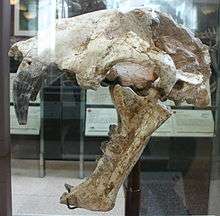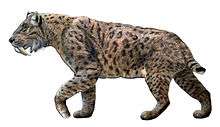Amphimachairodus
| Amphimachairodus Temporal range: Late Miocene 9.5–5.3 Ma | |
|---|---|
 | |
| A. giganteus skull. | |
| Scientific classification | |
| Kingdom: | Animalia |
| Phylum: | Chordata |
| Class: | Mammalia |
| Order: | Carnivora |
| Family: | Felidae |
| Subfamily: | †Machairodontinae |
| Tribe: | †Homotherini |
| Genus: | Amphimachairodus |
| Type species | |
| †Amphimachairodus giganteus Kretzoi, 1929 | |
| Species[1] | |
| |
Amphimachairodus is an extinct genus of large machairodonts belonging to the clade known as Eumachairodontia (true saberteeth) along with relatives like Smilodon and Homotherium.[2] It is also a member of the tribe Homotherini within Machairodontidae and is most closely related to such species as Xenosmilus, Homotherium itself, and Nimravides. It inhabited Eurasia, Northern Africa and North America during the late Miocene epoch.[3][4]
Description

There was marked sexual dimorphism in A. giganteus, with males being much larger than females.[5]
A single fossil specimen examined by Legendre and Roth was determined to have an approximate body mass of 201.8 kg. Amphiachairodus kabir was a large species from Central Africa whose size may have weighed 350–490 kg.[6] The species Amphimachairodus coloradensis (formerly Machairodus coloradensis) was a significantly large animal, about 1.2 m (3.9 ft) at the shoulder, according to skeletal and life reconstructions, potentially making it one of the largest known felids.[7]
Amphimachairodus was about 2 metres long and probably hunted as an ambush predator - its legs were too short to sustain a long chase, but it most likely was a good jumper. It probably used its canines to cut open the throat of its prey, severing the major arteries and possibly crushing the windpipe. Its teeth were rooted to its mouth and were not as delicate as those of most other saber-toothed cats of the time, which had extremely long canines that hung out of their mouths. The fangs of Amphimachairodus, however, were able to easily fit in its mouth comfortably while being long enough to be effective for hunting.[8]
This specimen was from a large male A. giganteus with the skull measuring 14 inches (36 cm) from the Late Miocene in China.[9] Deformation of the skull through natural fossilization processes has changed the shape slightly, making it asymmetrical, but overall it remains an excellent specimen for studying the cranial morphology of this particular genus and species.
For felines, this skull is very large, surpassing the size of most modern lions. When compared with a lion, it is long and very narrow, particularly in the muzzle and width of the zygomatic arches. Its sagittal crest is well pronounced. Compared with other machairodonts, the canines are stout and capable of large amounts of stress. This characteristic is slightly remodeled in females, whose canines are slimmer and generally longer.[10] Compared with females, the orbit of males are smaller, muzzles larger, the anterior-most portion of the nasal bones generally flare upwards slightly, and the downward slope of the dorsal edge of the skull in front of the orbit is not as pronounced, producing a straighter profile. Compared with the most well known machairodont Smilodon, commonly referred to as the "saber-toothed cat", the canines are much shorter, the facial portion again is much longer, and the teeth not reduced so far in number. Several machairodonts, namely Megantereon, bear flanges on the mandible, which are very reduced in A. giganteus though characteristics of the mandible associated with the flanges are present, particularly the lateral flattening of the anterior portion of the mandible, creating a cross section more square than semi-circular. The dental formula for this specimen is I3/3 C1/1 P2/2 M1/1.
Paleoecology
Amphimachairodus was an inhabitant of woodlands and open floodplains as based on finds in Pikermi in Spain and Shanxi Province in China, indicating it had habitat preferences similar to modern lions in many respects. Specimens recovered from Turolian deposits in indicate that the fauna living there was much the same, differing only by species in many cases. Among the creatures it shared its environment were bovids such as Parabos, the mastodon Anancus, the bear Agriotherium, fellow machairodont Metailurus, hyenas like Thalassictis, antelopes such as Tragoportax and camels such as Paracamelus, the horse Hipparion and the beaver-like Dipoides. The larger herbivores were likely common prey for Amphimachairodus, and it likely have competed with Agriotherium for food, likely having to yield kills to the bear and possibly also stealing kills from hyenas such as Thalassictis and from Metailurus when the opportunity arose.[11]
In North America, in places such as Coffee Ranch in Texas, Amphimachairodus coloradensis shared territory with Agriotherium as it had in Africa and Eurasia, but also shared territory with the feliform Barbourofelis and the canids Epicyon and Borophagus, and herbivores like the camel Aepycamelus, the pronghorn antelope Cosoryx, horses like Neohipparion and Nannippus, the peccary Prosthennops and rhinoceroses like Teleoceras.[12][13]
References
- ↑ Sardella, Raffaele; Werdelin, Lars (2007). "Amphimachairodus (Felidae, Mammalia) from Sahabi (Latest Miocene-earliest Pliocene, Libya), with a review of African Miocene Machairodontinae". Revista Italiana di Paleontologia e Stratigrafia. 113 (1).
- ↑ Christiansen, P. (2012). "Phylogeny of the sabertoothed felids (Carnivora: Felidae: Machairodontinae)". Cladistics: n/a. doi:10.1111/cla.12008.
- ↑ Werdelin, L; O'Brien, S.J.; Johnson, W.E.; Yamaguchi, N. (2010). "Phylogeny and evolution of cats (Felidae).". In Macdonald, D.W.; Loveridge, A.J. Biology and Conservation of Wild Felids. Oxford: Oxford University Press.
- ↑ Anton, Mauricio (2013). Sabertooth.
- ↑ Turner, A.; Antón, M. (1997). The Big Cats and Their Fossil Relatives: An Illustrated Guide to Their Evolution and Natural History. Columbia University Press. ISBN 978-0231102292. OCLC 34283113.
- ↑ Peignéa, Stéphane; Louis de Bonisa; Andossa Likiusb; Hassane Taïsso Mackayeb; Patrick Vignauda; Michel Bruneta (2005). "A new machairodontine (Carnivora, Felidae) from the Late Miocene hominid locality of TM 266, Toros-Menalla, Chad". Comptes Rendus Palevol. 4 (3): 243–253. doi:10.1016/j.crpv.2004.10.002. Retrieved 2013-01-16.
- ↑ Turner, Alan; Anton, Mauricio (1997). The Big Cats and Their Fossil Relatives.
- ↑ Legendre, S.; Roth, C. (1988). "Correlation of carnassial tooth size and body weight in recent carnivores (Mammalia)". Historical Biology. 1 (1): 85–98. doi:10.1080/08912968809386468. Retrieved 2011-06-03.
- ↑ "Male Machairodus giganteus skull". Black Hill Institute.
- ↑ "Female Machairodus giganteus skull".
- ↑ Antón, Mauricio (2013). Sabertooth. Bloomington, Indiana: University of Indiana Press. pp. 53–54. ISBN 9780253010421.
- ↑ Antón, Mauricio (2013). Sabertooth. Bloomington, Indiana: University of Indiana Press. p. 39. ISBN 9780253010421.
- ↑ Turner, Alan (1997). The Big Cats and their fossil relatives. New York: Columbia University Press. p. 201. ISBN 0-231-10228-3.
